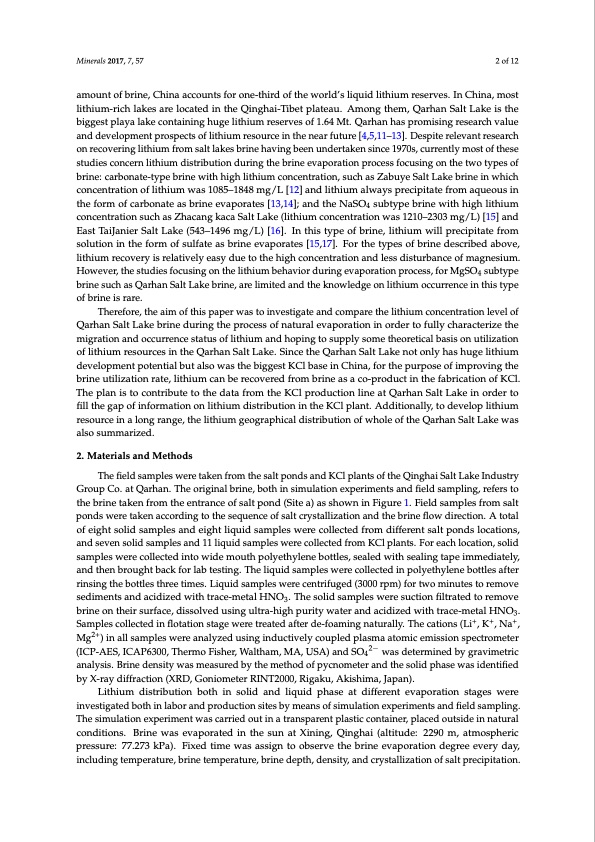
PDF Publication Title:
Text from PDF Page: 002
Minerals 2017, 7, 57 2 of 12 amount of brine, China accounts for one-third of the world’s liquid lithium reserves. In China, most lithium-rich lakes are located in the Qinghai-Tibet plateau. Among them, Qarhan Salt Lake is the biggest playa lake containing huge lithium reserves of 1.64 Mt. Qarhan has promising research value and development prospects of lithium resource in the near future [4,5,11–13]. Despite relevant research on recovering lithium from salt lakes brine having been undertaken since 1970s, currently most of these studies concern lithium distribution during the brine evaporation process focusing on the two types of brine: carbonate-type brine with high lithium concentration, such as Zabuye Salt Lake brine in which concentration of lithium was 1085–1848 mg/L [12] and lithium always precipitate from aqueous in the form of carbonate as brine evaporates [13,14]; and the NaSO4 subtype brine with high lithium concentration such as Zhacang kaca Salt Lake (lithium concentration was 1210–2303 mg/L) [15] and East TaiJanier Salt Lake (543–1496 mg/L) [16]. In this type of brine, lithium will precipitate from solution in the form of sulfate as brine evaporates [15,17]. For the types of brine described above, lithium recovery is relatively easy due to the high concentration and less disturbance of magnesium. However, the studies focusing on the lithium behavior during evaporation process, for MgSO4 subtype brine such as Qarhan Salt Lake brine, are limited and the knowledge on lithium occurrence in this type of brine is rare. Therefore, the aim of this paper was to investigate and compare the lithium concentration level of Qarhan Salt Lake brine during the process of natural evaporation in order to fully characterize the migration and occurrence status of lithium and hoping to supply some theoretical basis on utilization of lithium resources in the Qarhan Salt Lake. Since the Qarhan Salt Lake not only has huge lithium development potential but also was the biggest KCl base in China, for the purpose of improving the brine utilization rate, lithium can be recovered from brine as a co-product in the fabrication of KCl. The plan is to contribute to the data from the KCl production line at Qarhan Salt Lake in order to fill the gap of information on lithium distribution in the KCl plant. Additionally, to develop lithium resource in a long range, the lithium geographical distribution of whole of the Qarhan Salt Lake was also summarized. 2. Materials and Methods The field samples were taken from the salt ponds and KCl plants of the Qinghai Salt Lake Industry Group Co. at Qarhan. The original brine, both in simulation experiments and field sampling, refers to the brine taken from the entrance of salt pond (Site a) as shown in Figure 1. Field samples from salt ponds were taken according to the sequence of salt crystallization and the brine flow direction. A total of eight solid samples and eight liquid samples were collected from different salt ponds locations, and seven solid samples and 11 liquid samples were collected from KCl plants. For each location, solid samples were collected into wide mouth polyethylene bottles, sealed with sealing tape immediately, and then brought back for lab testing. The liquid samples were collected in polyethylene bottles after rinsing the bottles three times. Liquid samples were centrifuged (3000 rpm) for two minutes to remove sediments and acidized with trace-metal HNO3. The solid samples were suction filtrated to remove brine on their surface, dissolved using ultra-high purity water and acidized with trace-metal HNO3. Samples collected in flotation stage were treated after de-foaming naturally. The cations (Li+, K+, Na+, Mg2+) in all samples were analyzed using inductively coupled plasma atomic emission spectrometer (ICP-AES, ICAP6300, Thermo Fisher, Waltham, MA, USA) and SO42− was determined by gravimetric analysis. Brine density was measured by the method of pycnometer and the solid phase was identified by X-ray diffraction (XRD, Goniometer RINT2000, Rigaku, Akishima, Japan). Lithium distribution both in solid and liquid phase at different evaporation stages were investigated both in labor and production sites by means of simulation experiments and field sampling. The simulation experiment was carried out in a transparent plastic container, placed outside in natural conditions. Brine was evaporated in the sun at Xining, Qinghai (altitude: 2290 m, atmospheric pressure: 77.273 kPa). Fixed time was assign to observe the brine evaporation degree every day, including temperature, brine temperature, brine depth, density, and crystallization of salt precipitation.PDF Image | Lithium during Brine Evaporation and KCl Production Plants

PDF Search Title:
Lithium during Brine Evaporation and KCl Production PlantsOriginal File Name Searched:
minerals-07-00057-v2.pdfDIY PDF Search: Google It | Yahoo | Bing
Product and Development Focus for Infinity Turbine
ORC Waste Heat Turbine and ORC System Build Plans: All turbine plans are $10,000 each. This allows you to build a system and then consider licensing for production after you have completed and tested a unit.Redox Flow Battery Technology: With the advent of the new USA tax credits for producing and selling batteries ($35/kW) we are focussing on a simple flow battery using shipping containers as the modular electrolyte storage units with tax credits up to $140,000 per system. Our main focus is on the salt battery. This battery can be used for both thermal and electrical storage applications. We call it the Cogeneration Battery or Cogen Battery. One project is converting salt (brine) based water conditioners to simultaneously produce power. In addition, there are many opportunities to extract Lithium from brine (salt lakes, groundwater, and producer water).Salt water or brine are huge sources for lithium. Most of the worlds lithium is acquired from a brine source. It's even in seawater in a low concentration. Brine is also a byproduct of huge powerplants, which can now use that as an electrolyte and a huge flow battery (which allows storage at the source).We welcome any business and equipment inquiries, as well as licensing our turbines for manufacturing.| CONTACT TEL: 608-238-6001 Email: greg@infinityturbine.com | RSS | AMP |